Fahlman B.D. Materials Chemistry
Подождите немного. Документ загружается.

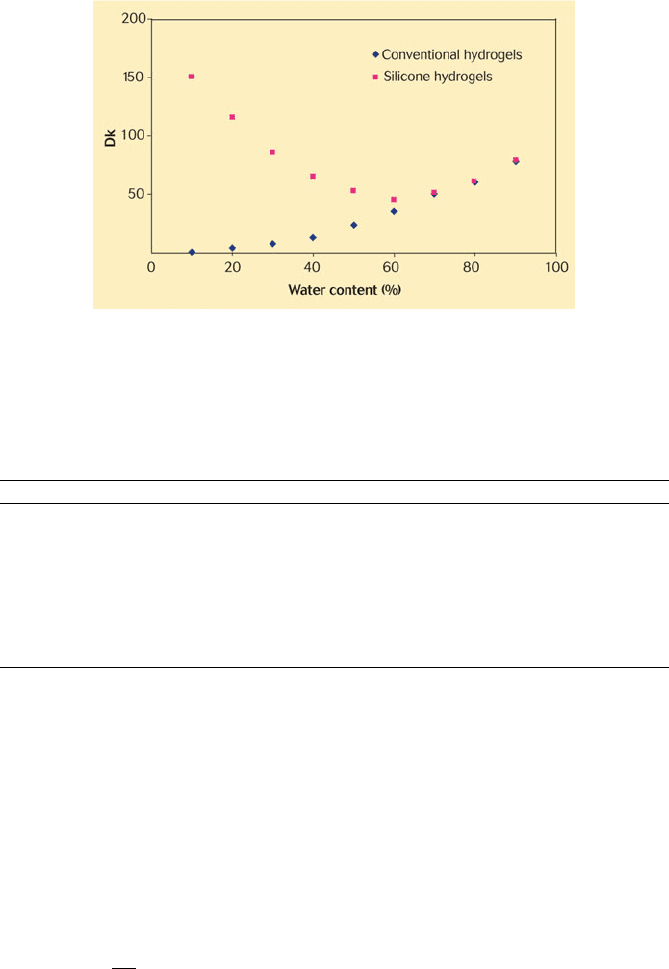
wearer (both open-eye and closed-eye).
[82]
Most typical modern RGP lenses have
Dk/t values of 15–25 Barrers cm
1
, whereas soft lenses have much higher values
(Table 5.5). For a lens to be approved for extended-wear applications, the Dk value
must be 100 Barrers.
J=
Dk
t
DP,ð5Þ
where:
Figure 5.51. Variation of oxygen permeability with equilibrium water content for conventional and
silicone-based hydrogels. Reproduced with permission from Optician, 2005, 230, 16.
Table 5.5. Oxygen Transmissibility for Various Soft Contact Lenses
a
Lens Dk/t
b
J
open-eye
c
% of maximum J
closed-eye
c
% of maximum
100 mm HEMA 7.5 3.95 52% 1.50 25%
Acuvue 2 26 6.65 88% 4.09 68%
Acuvue advance 86 7.31 97% 5.55 92%
Purevision 110 7.37 98% 5.68 94%
O
2
optix 138 7.4 98% 5.8 96%
Acuvue oasys 147 7.4 98% 5.8 96%
Focus night and day 175 7.44 99% 5.84 97%
No lens 1 7.54 100% 6.04 100%
a
Data taken with permission from (a) French, K. Optician 2005, 6030, 16 and (b) Morgan, P.; Brennan, N.
Optician 2004, 5937, 27.
b
Manufacturer values quoted for 3.00DS lenses.
c
Units: mLcm
2
h
1
.
408 5 Polymeric Materials
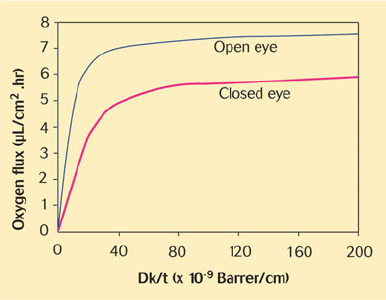
J ¼ oxygen flux (units: m s
1
)
Dk/t ¼ transmissibility (i.e., permeability per unit thickness, t); D ¼ dif fusion-
coefficient, and k ¼ solubility coefficient
DP ¼ difference in oxygen partial pressure between the front and back of the
lens (P
front
: 159 mmHg (open eye) and 59 mmHg (closed eye); P
back
/ lens
transmissibility)
As one would expect, there is a difficulty in determining the pressure at the
posterior surface of the lens; consequently, a value known as the equivalent oxygen
percentage (EOP, Eq. 6) may be used. The EOP provides an indirect measure of this
pressure, determined empirically by placing a membrane-covered sensor against the
corneal surface and determining its oxygen consumption rate.
[83]
Whereas lenses
with low Dk/t values such as PMMA result in very rapid O
2
-uptake rates, a lens-free
cornea would deplete oxygen at a much slower rate. As Figure 5.52 illustrates, there
is a large increase in the oxygen flux with increasing Dk/t until a threshold value is
reached, corresponding to meeting the corneal oxygen demand.
EOP = 0:252ðWCÞ2 :912logðLÞ20:611;ð6Þ
where:
WC ¼ water content of the lens (relevant for ‘soft’ hydrogel lenses)
L ¼ thickness of the lens, in mm (typical center thicknesses: 30–50 mm for soft;
ca. 100 mm for hard)
As one can see from Eq. 6, the permeability of a soft contact lens is directly
proportional to its water content (Figure 5.53). Whereas the moisture content of
early PHEMA lenses was only ca. 35%, more recent silicone-based hydrogels
contain up to 70% water. Though hydrophilic lenses are able to absorb water and
permit extended wear without corneal irritation, an increase in water content also
corresponds to lower mechanical strength that may result in tearing/scratching.
Figure 5.52. The relationship of oxygen flux and oxygen transmissibility for open- and closed-eye
wearing conditions. Reproduced with permission from Optician, 2005, 230, 16.
5.3. “Soft Materials” Applications: Structure vs. Properties 409
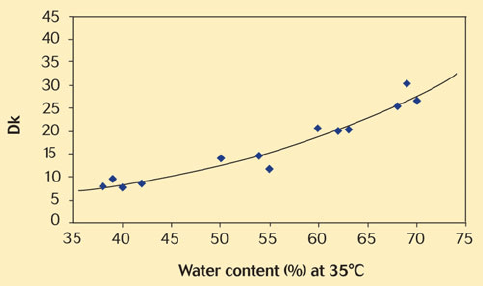
Drug delivery
Anyone who has taken time-release medications (e.g., nasal decongestants, allergy
medications, etc.), or witnessed a loved one undergo chemotherapy has experienced
a tangible application for biodegradable polymers: as drug-delivery systems
(DDS).
[84]
In the last few years, these materials have evolved from pills that generate
systemic negative side-effects, to miniaturized devices that are able to target the
region of interest and control the kinetics of drug release. Current DDS feature
both spatial control (allowing for lower dosage and decreased side effects)
and temporal control (to minimize fluctuations from the therapeutic window).
[85]
Typical means of control over drug release include: diffusion (membrane-controlled
– osmosis, swelling), chemical (biodegradable polymer backbones), particulate
(polymer-drug conjugates, liposome systems, polymeric micelle systems, etc.), and
responsive (T, solvents, pH, mechanical/magnetic/ultrasound, etc.). Future “smart”
DDS are currently in development, which will contain a variety of sensors for the
‘on-demand’ release of a drug in the proper dosage based on the patient’s varying
conditions. For instance, the delivery of insulin based on varying glucose levels, and
growth hormones at key developmental stages to promote tissue growth.
[86]
An ideal “smart” drug-delivery agent will have the following characteristics:
[87]
(i) Inexpensive fabrication;
(ii) Ease of drug loading;
(iii) Biocompatible – minimal trauma during both ingestion/implantation and drug
delivery;
(iv) Facile tracking within the body, with external control via pre-/post-programming;
(v) Small size for ease of ingestion/injec tion and to allow for prec ise spatial
positioning of drug release (<1 mm is ideal for passage through all capillaries
with minimal risk of damage or embolism).
[88]
Figure 5.53. Relationship between oxygen permeability and water content for conventional hydrogel
lenses at 35
C. Reproduced with permission from Optician, 2005, 230, 16.
410 5 Polymeric Materials

No current device meets all of these parameters. Diffusion-controlled release is
demonstrated by transdermal patches (e.g., birth-control, nicotine, etc.), whereas
particulates such as metallic micro-/nanoparticles have been used to ablate cancer
cells by localized heating with near-IR light.
[89]
Whereas normal blood vessels
have pore sizes <100 nm, the vessels adjacent to cancer cells have pore sizes
between 100 and 200 nm. Hence, if DDS particulates (e.g., liposomes, polymeric
micelles, metallic nanoparticles) are of this size regime, they will automatically
situate nearby cancer cells. However, it usually takes at least 1 day of blood
circulation to accumulate sufficient amounts. In order to “hide” the particles from
the immune system, the partic ulates must be covered with a ‘stealth lipsome’ such as
poly(ethyleneglycol), PEG; otherwise, the particulates will be filtered out of the
body via the liver as urine.
Though the above strategies are currently in use for a variety of treatment options,
most efforts in the design of DDS have been focused on biodegradable reservoir
systems; for example, the treatment of prostate cancer and protein hormone delivery.
In these materials, degradation occurs in four steps:
(i) Water flows into the device, swelling the matrix and ester bond cleavage;
(ii) The interior degrades faster due to a high concentration of acid (product, catalyst);
(iii) Oligomers become solubilized and diffuse out of the device;
(iv) Slow erosion of the shell.
The most common biodegradable polymers used for DDS include PGA, PLA and
their copolymers. The rate of degradation may be controlled by its composition as
well as crystallinity . However, due to the faster degradation of the interior, the
localized acid concentration may become high enough to harm the therape utic agent.
A base such as Mg(OH)
2
may be incorporated to offset this acidity. For the treatment
of malignant brain cancer, the use of polyanhydrides (e.g., bis(p-carboxyphenoxy
propane) – PCPP, XII) has proven successful; control over degradation rates may be
afforded by decorating the backbone with aromatic groups, as well as copolymeri-
zation (e.g., with sebacic acid – SA, XIII). The use of nonlinea r polyanhydrides
offers the benefit of enhanced mechanical properties , with the degra dation rate being
controlled by copolymerization (e.g., an erucic acid dimer/sebacic acid copolymer,
XIV, and a ricinoleic acid/s ebacic acid copolymer, XV).
5.3. “Soft Materials” Applications: Structure vs. Properties 411
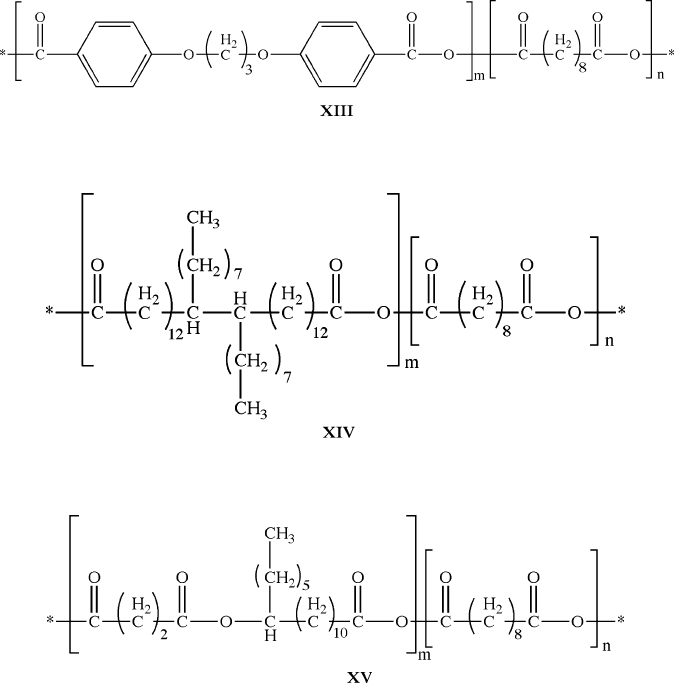
Another cla ss of biodegradable polymers used for DDS include s poly(orthoe-
sters), POEs. The benefits of these polymers include facile synthesis and control
over degradation rates and mechanical properties (e.g., POE XVI – rigid vs. POE
XVII – flexible liquid/gel). Due to the highly hydrophobic nature of their backbones,
POEs normally exhibit slow degradation; however, copolymerization with PLA
(XVIII, used for periodontal d isease and anesthetics) offers control over these
kinetics. Though originally developed as flame retardants, poly(phosphoesters)
may also be used as biodegradable DDS (e.g., polylactophate (XIX), used for the
controlled release of insulin and paclitaxel (cancer treatment)). These structures
feature an extensive range of mechanical properties, while generating non-toxic
degradation byproducts of phosphate ions, alcohols and diols.
412 5 Polymeric Materials
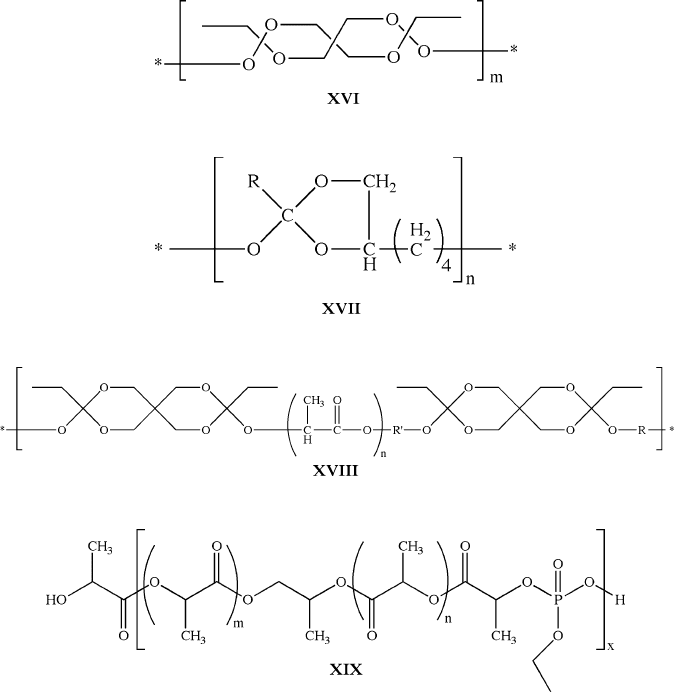
As mentioned earlier (Figure 5.32), dendritic polymers may also be used for
drug-delivery applications. Due to their unique 3-D structures and the high avail-
ability and tunability of surface functional groups, drugs may be loaded within the
interior, as well as attached to the periphery via electrostatic or covalent interactions.
The use of PAMAM dendrimers is in development for the delivery of doxorubicin,
an anti-cancer drug, as well as VivaGel
®
, a vaginal anti-HIV microbicide that is
currently in Phase II clinical trials.
[90]
However, PAMAM dendrimers resist degra-
dation within the body, which has spurred recent interest in the development of
5.3. “Soft Materials” Applications: Structure vs. Properties 413
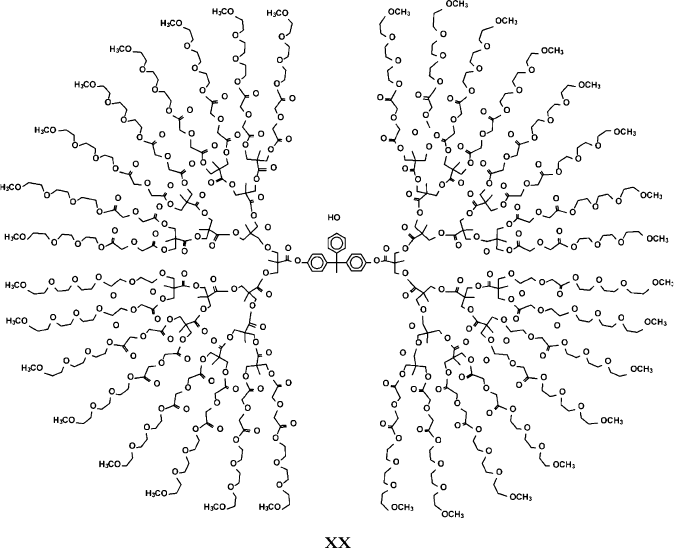
alternative dendritic polymers that are biodegradable. For example, Frechet and
coworkers have developed polyester dendrimers based on the monomeric unit 2,2-bis
(hydroxymethyl)propanoic acid, XX, for the controlled delivery of doxorubicin.
[91]
Biodegradable bifunctional dendrimers, XXI, may also be synthesized, which will
offer a greater opportunity for the binding of varied functionalities (e.g., drugs,
targeting/imaging agents, etc.) to the periphery relative to symmetric analogues.
[92]
In recent years, advanced DDS have been fabricated using advanced lithographic
techniques. As briefly discussed in Chapter 4, ‘soft’ imprint lithographic techniq ues
such as solvent-assisted micro-molding (SAMIM), micro-molding in capillaries
(MIMIC) and microcontact printing (m-CP or MCP) most frequently employ
PDMS as the material of choice for the mold. Though PDMS is used due to its
UV transparency, biocompatibility, gas permeability, and low Young’s modulus
(allowing for conformal contact and facile release from the (nonplanar) master
without cracking), its use for small-feature patterning has recently been usurped
by fluorinated analogues.
414 5 Polymeric Materials
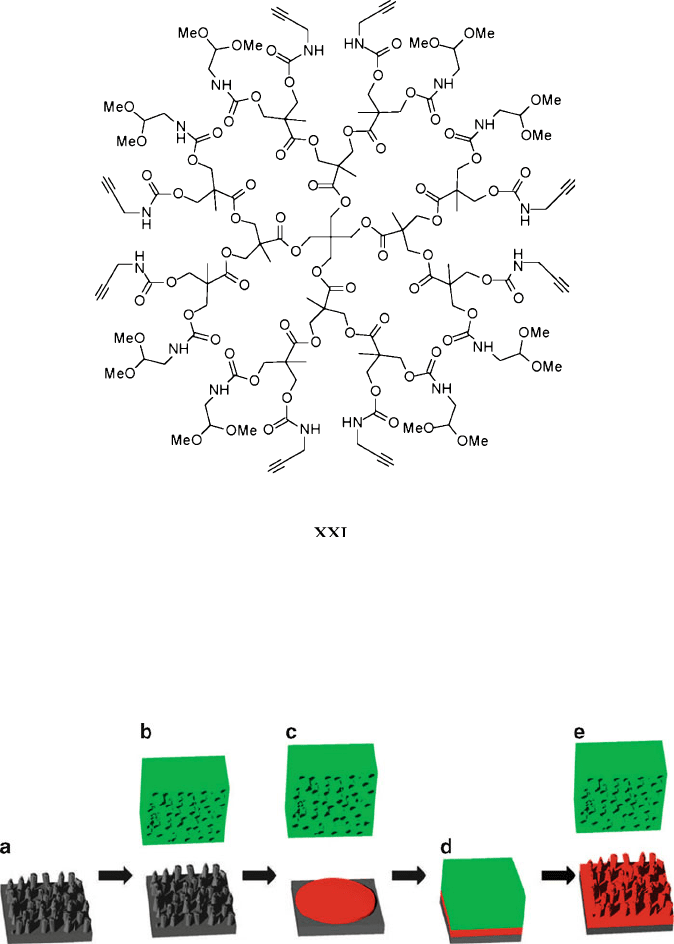
Desimone and coworkers have developed fluorinated elastomers for a technique
coined as pattern replication in nonwetting templates (PRINT), which allows one
to fabricate surface-bound or free polymeric structures of vir tually any size and
shape, with feature sizes reaching well below 100 nm.
[93]
Figure 5.54 illustrates the
PRINT technique, which is analogous to the MIMIC technique, with the use of
Figure 5.54. Illustration of the PRINT process. Shown are (a) Si master template, (b) mold release from
master template, (c) molding a liquid precursor, (d) pattern transfer to a substrate at elevated temperature
and pressure, and (e) mold release from replica film. Reproduced with permission from Chem. Mater.
2008, 20, 5230. Copyright 2008 American Chemical Society.
5.3. “Soft Materials” Applications: Structure vs. Properties 415
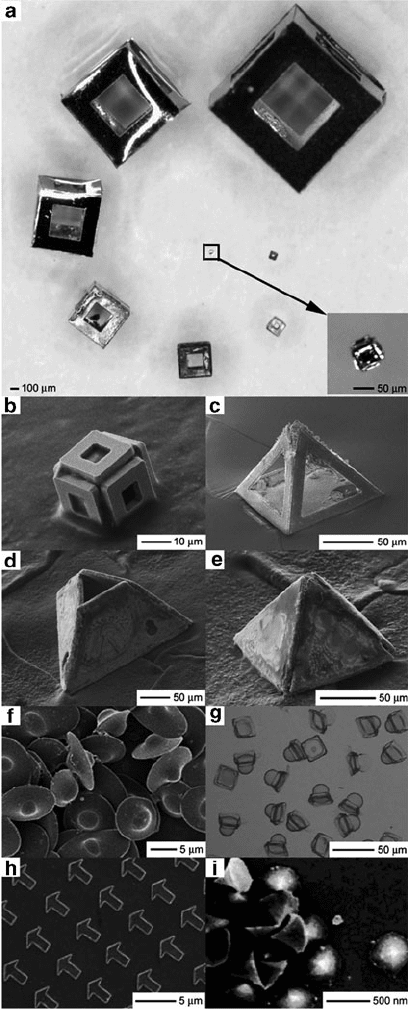
416 5 Polymeric Materials
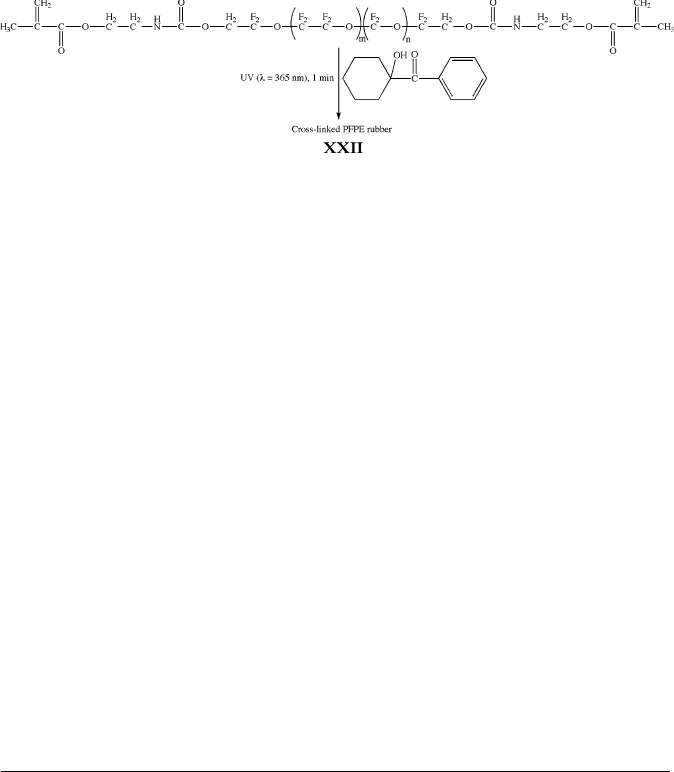
perfluoropolyether (PFPE, XXII) elastomers to realize the following benefits,
relative to standard PDMS molds:
(i) Lower surface energy, which allows selective filling of nanosized cavities in
the mold with any organic liquid;
(ii) Significantly greater swelling resistance in organic solvents;
(iii) Greater chemical inertness, which allows the array of surface features to be
easily separated from the mold to yield free-standing micro- or nanostructures;
(iv) Greater tunability of the modulus by varying the precursor molecular weight,
which allows one to pattern a variety of sol–gels into <100 nm features.
In addition to using PRINT to fabricate a variety of complex shapes (see
Chapter 4 – Figure 4.73 and Figure 5.55f–i), a cleve r approach employs ph ot olith o-
graphy and sel f-as sembly to generate cubi c and pyramidal structures via “micro-/
nano-origami” (Figure 5.55a–g and Figure 5.56). In this approach, a 2-D struct ure is
formed with temperatu re-s ens it ive hinge s that fold into the desired 3-D shape
upon heating.
[94]
AsshowninFigure5.56 (bottom), the drug-release characteristics
may be fine-tuned in these structures, from isotropic to anisotropic, based on the
relative porosity/permeability of its sidewalls.
5.3.2. Conductive Polymers
Though one generally considers polymeric materials as being non-conductive, there
are specific structures that feature either metallic or semiconductive electrical proper-
ties. Unlike their inorganic analogues, conductive polymers generally feature high
elasticity, toughness, solvent solubility, and low-temperature synthetic routes with
facile structural (and property) tunability. Accordingly, these polymers are used for an
Figure 5.55. (a) An optical image showing free-standing, self-assembled fabricated cubic containers
over 2 orders of magnitude in size from 2 mm to 50 mm and (b) 15 mm along with (c–e) different shapes.
(f) Scanning electron micrograph of polystyrene particles, “UFOs”, created by film stretching techniques.
Reproduced with permission from Proc. Nat. Acad. Sci. 2006, 103, 4930. (g) Optical micrographs of
microcapsules in water, reproduced with permission from Small 2007, 3, 412. (h) SEM image of 300 nm
conical-shaped poly(lactic acid) particles generated by using the Particle Replication In Nonwetting
Templates (PRINT) method. (i) Manipulation of shape using PRINT: 3 mm arrow poly(ethylene glycol)
particles. Images (a–c) reproduced with permission from Langmuir 2007, 23, 8747, (d–e) reproduced with
permission from J. Am. Chem. Soc. 2006, 128, 11336, and images (h–i) reproduced with permission from
J. Am. Chem. Soc. 2005, 127, 10096. Copyright American Chemical Society.
ä
5.3. “Soft Materials” Applications: Structure vs. Properties 417
